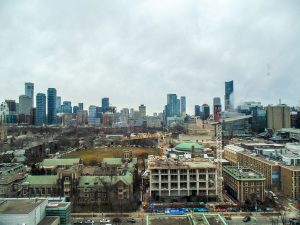Proposal designates character areas

PHOTO BY BRIAN BURCHELL/GLEANER NEWS: Audience members at a community meeting fear that extending the University of Toronto’s Planning Act exemptions for its St. George campus would lead to additional new development in the area.
By Brian Burchell
The City of Toronto hosted a public meeting to consider expanding the University of Toronto’s exemptions from the Planning Act early last month. Billed as a “pre-application consultation” by the city, it drew community members who questioned the need to broaden the university’s powers.
Approved by the city in 1993 and 1997, the U of T Master and Secondary plans are essentially an area-specific bylaw enabling the university to bypass the Committee of Adjustment when development proposals for its St. George Campus exceed standard restrictions around minimal set-back, building heights, and density.
“We need to keep the institution in the institutional area and out of our nice community and houses”—Bob Barnett, local resident
The Secondary Plan specified the location of these buildings, and limited the exemptions. The existing bylaw covers 29 potential sites, 16 of which have been or are currently being developed, including the new engineering tower at 47-55 St. George Street north of College Street. It exemplifies the type of infill, height, density, and set-back that the university wants to retain the right to develop under an amended secondary plan.
The proposal covers the same 108 hectares as the Secondary Plan, roughly bounded by College Street, Bloor Street West, Spadina Avenue, and Bay Street. It would apply to building owners in that area, like the Royal Ontario Museum, even though the university owns only 77 of the 108 hectares.
The university has requested carte blanche to build any structure that is consistent with what it has classified as “character areas”: the Historic Campus Character Area, the North Campus Character Area, and the Huron Sussex Character Area. According to the city’s planning department, the planning objectives of each character include conserving and protecting cultural heritage resources, enhancing and expanding the public realm, and identifying opportunities for new development.
City planner Paul Johnson said that while the city agrees with certain aspects of the plan, it still has significant concerns.
It supports basing the proposed policies on heritage and public realm, “looking at it as more of a cultural heritage landscape”, standardizing the building-by-building analysis, and encouraging more cycling and pedestrian activity.
However, said Johnson, the challenge is to find the right balance between flexibility and precision in the area.
“Right now we find the plan overly flexible. It does not provide enough certainty, does not provide enough protection for heritage elements, and does not prevent the significant intrusion of other uses such as private residential and commercial activity in the area.”
He also questioned whether the existing street boundaries still make sense, or whether they should be expanded.
Pino Di Mascio, a partner at Urban Strategies Inc. representing the university at the meeting, said the shift to character areas as a planning guide “is consistent with what is happening elsewhere in the city.
“So much heritage and low-rise existing institutions [need] to be maintained. [There’s also] a need to create an aesthetically pleasing public realm that meets the needs of the students, the staff, the faculty, and the people that meander through the university.”
But it was the identification of opportunities for new development that concerned most of the speakers at the meeting.
Local resident Ray Wolf said the university should be more transparent, and demanded to know whether it planned to put condominiums in the mixed-use areas.
“The university…has been busy acquiring parcels of land south of College Street and east of Spadina [Avenue] for years,” said Ceta Ramkhalawansingh, former councillor (Ward 20, Trinity-Spadina), who spoke on behalf of the Grange Residents’ Association. She also questioned the need for further development when the university’s own documents suggest it has no plans to add students to the St. George Campus, and in fact is planning to change the mix to a more graduate-based student body.
Bob Barnett, a local resident and graduate of the university’s school of architecture in the 1960s, characterized the university’s conduct “as the gorilla escaping, trying to get south of College [Street] and west of Spadina [Avenue]. We need to keep the institution in the institutional area and out of our nice community and houses.”
Barnett praised some the proposal’s language, like “new development will transition into the neighbouring city edges in a context appropriate manner”, but observed that this is not consistent with the U of T’s conduct.
“The university has come to beat up our neighbourhood at Sussex and Spadina and build a 23-storey building right beside two-and-half-storey houses…. There are all sorts of nice words around the room but it ain’t happening.”
The city said it plans to host additional community consultations in the future, each focusing on the plan’s key elements: heritage, open space, active transportation, and built-form. The university is expected to make its formal application in early 2018.
In 1993, Brian Burchell was a governor of the university, and participated in the creation of the original Master Plan. He publishes this newspaper.
READ MORE:
NEWS: New chapter for student residence? (February 2017)
NEWS: Preventing a wall of towers (October 2016)
CHATTER: Two new rezoning applications submitted to city (September 2016)
NEWS: Tall tower before OMB, as city battles back with block study (August 2016)
NEWS: Planning for the future (May 2016)
DEVELOPINGS: Annual review reflects tension between community activism and OMB (March 2016)
